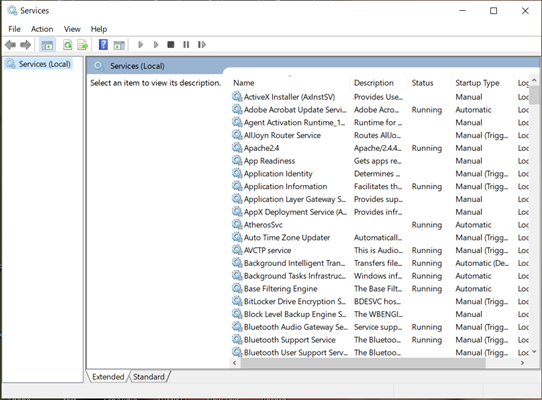Though a distinct module for wamp server is available over the internet and one can download and install it as a package, wamp stack components can be installed separately (manually). Here we have shown how to install and setup wamp stack components separately (manually).
Significance:
It is very essential for a Windows user who wants to establish his/her own dynamic web presence. A WAMP stack will enable you to test your own web pages on your own server on your own windows pc. Once successful, you can easily put your web pages and server code into the actual domain server.
What is WAMP stack?
It is a stack to set up your own server on your Windows PC. First you need Windows environment (the OS), then you need to install Apache server, after that you need to install PHP and then setup your MYSQL database. In short it is Windows-Apache-MySQL-PHP stack. PHP is needed for your server-side coding.
For users of other environments like linux, they need to setup their LAMP stack which is Linux-Apache-MySQL-PHP stack. There are other stacks like MAMP – the Mac-Apache-MySQL-PHP stack etc.
Start:
As a Windows user we already have windows installed in our pc. I have Windows 10 installed in my pc. Now I need to install and setup Apache.
Before that we need to disable IIS in our Windows PC, if it is enabled. To disable IIS, follow the steps below:
1. Go to Services window by typing services in search bar at the bottom left; from there disable IIS admin service.
2. Now open "Turn Windows features on or off" in the same way.
3. Go to Internet Information Services
4. Click the square next to it so that it becomes empty.
5. Click OK and reboot the PC.
Start with Apache:
We need to start apache as a service in our Windows Pc. Apache can be downloaded from any of its official sites. (it an open source software).
Before downloading and installing Apache we need to uninstall Apache if it is previously installed anytime. The code to uninstall Apache is >httpd-k uninstall
[Note: httpd is available in bin folder of the root directory. If apache is installed in c:\Apache24 then the command will be available in c:\Apache24\bin> folder.
Again,
the command prompt( dos prompt) should be opened with administrative privileges.
It is necessary to restart the apache server each time.
]
To check whether Apache is running in our system we need to check the services running in our system. For windows 10 users we need to write services in the search box in the status bar.
On hitting enter $\Leftarrow$ the services window will open. In this window we will get all the services running in our system. As I have Apace 2.4 already installed in my system the Apache service is seen to be running in my system. Below is the figure:
So, if apache is installed in our system, we need to uninstall it first. To do that first we need to check where Apache was installed in our system. Mostly it is in the C:\Apache directory. For me it is C:\Apache24 directory. And the httpd is in the C:\Apache24\bin directory. So, we need to go to C:\Apache24\bin> and then >httpd -k uninstall
If you don’t have Apache installed in your system You can start with next step:
Step 1:
Install the Microsoft VC++ Redistributable. We can do this from
http://www.apachelounge.com/download
. And look for 2.4.x VC11/14/VC15/VC1 link for windows 32 bit or 64 bit processor. In my case, my pc was Windows10 64 bits.
Be sure you installed latest 14.25.28508.3 Visual C++ Redistributable for Visual Studio 2015-2019 : vc_redist_x64 or vc_redist_x86 see Redistributable
Step 2:
Now download the zip file httpd-2.4.x-win64-VS16.zip from
http://www.apachelounge.com/download/
for Apache 2.4.
Unzip the zip file, then rename the unzipped folder to anything suitable. I renamed it as Apache24. Put the folder in C:\ directory. So, my Apache is now at C:\Apache24.
Step 3:
Now get the file httpd.conf located at C:\Apache24\conf directory. It is a text file.
Open it with a suitable editor. I used Notepad++ for ease.
Specify the ServerRoot in this file: change it accordingly[ we have to uncomment and change these lines accordingly]
Define SRVROOT "c:/Apache24"
ServerRoot "${SRVROOT}"
Now specify the document root as in the following way: [We have to uncomment and change these lines accordingly]
DocumentRoot "${SRVROOT}/htdocs"
<Directory "${SRVROOT}/htdocs">
……………
…………..
</Directory>
Step 4:
Now, at the command prompt, go to the bin folder of Apache24 i.e. C:\Apache24\bin>. Put there httpd$\leftarrow$. This will will start apache services in your system.
Always remember to get the Command Prompt with Administrative privilege.
To check whether apache properly started in your system or not, you need to go to your internet browser and type in the address bar:
http://localhost. Press Enter. If the browser shows “It Works”, it ensures that Apache is working successfully.
Actually, the Apache server executes the index.html or index.php file stored in the document root; This file is preinstalled when Apache is installed.
Now, again at the command prompt window, press CTRL + C$\leftarrow$. this will stop Apache and command prompt will come back again.
Note: whenever there is any change in apache system ie. httpd.conf or any allied files, you need the restart apache.
We can restart Apache with the following command:
>httpd -k restart
httpd command path should be accessible from the document root & remember to put command prompt in administrative mode.
Next Read:
Setup your own WAMP stack – Part II
Next Read:
Setup your own WAMP stack – Part III






